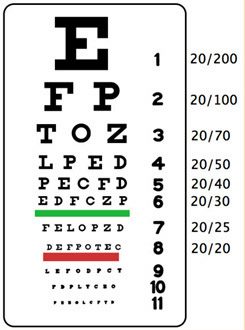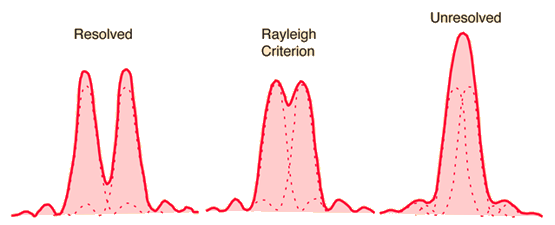What is 20/20 Vision?
Visual acuity is typically measured with the use of a standard eye chart called the Snellen chart. It was devised by Dr. Hermann Snellen, a Dutch Ophthalmologist, in 1862. It was originally used at a standard distance of 6 meters, which in U.S. common units is about 20 feet.

Snellen Chart from Wikipedia | Where such units are used, normal vision came to be characterized by the fraction 20/20, which corresponded to being able to distinguish the letters on the fourth line up from the bottom at a distance of 20 feet. The E on the chart has a standard height of 88 mm and the other letters are scaled accordingly. The basic scheme is that the letters two rows down are half the size, and two rows up twice the size. The nominal designations of visual acuity as a number ratio could be based on which lines you could read. If you could just resolve the letters two rows up from the normal vision line at 20 feet, your acuity would be labeled 20/40 and if you could resolve two lines down it would be labeled 20/10.
|
Another way of saying it is that if you vision is 20/40, you can just resolve at 20 feet what a person with normal vision could resolve at 40 feet. A visual acuity of 20/200 with the best possible correction with lenses is a nominal condition for being considered legally blind.
If the above describes the standard for normal vision, what are the factors which limit the resolution of human vision? To examine whether diffraction is the limiting factor, it is interesting to compare this standard of resolution with the limits imposed by diffraction. If the E on the chart (20/200) is 88mm high, then the 20/20 line would have letters of height 8.8 mm.

The Rayleigh criterion for diffraction-limited vision for an iris diameter of 5 mm and a wavelength of 500 nm is:

So 20/20 is about 12x the Rayleigh criterion. Ackerman reports that the
data show:

This is another example of the remarkable nature of human senses: the most acute vision is within about a factor of two of the physical limits imposed by diffraction!
According to a British standard quoted by Wikipedia, the minimum illumination for Snellen charts should be 480 lux. If the illumination is increased, the iris will constrict more and the diffraction at the smaller aperture would tend to diminish the acuity. However, the smaller aperture also reduces the effects of any aberrations in the lens, which would act to increase visual acuity. The conventional wisdom is that persons see better in bright light, suggesting that the gain in overcoming aberrations is greater than the loss from diffraction.
|






